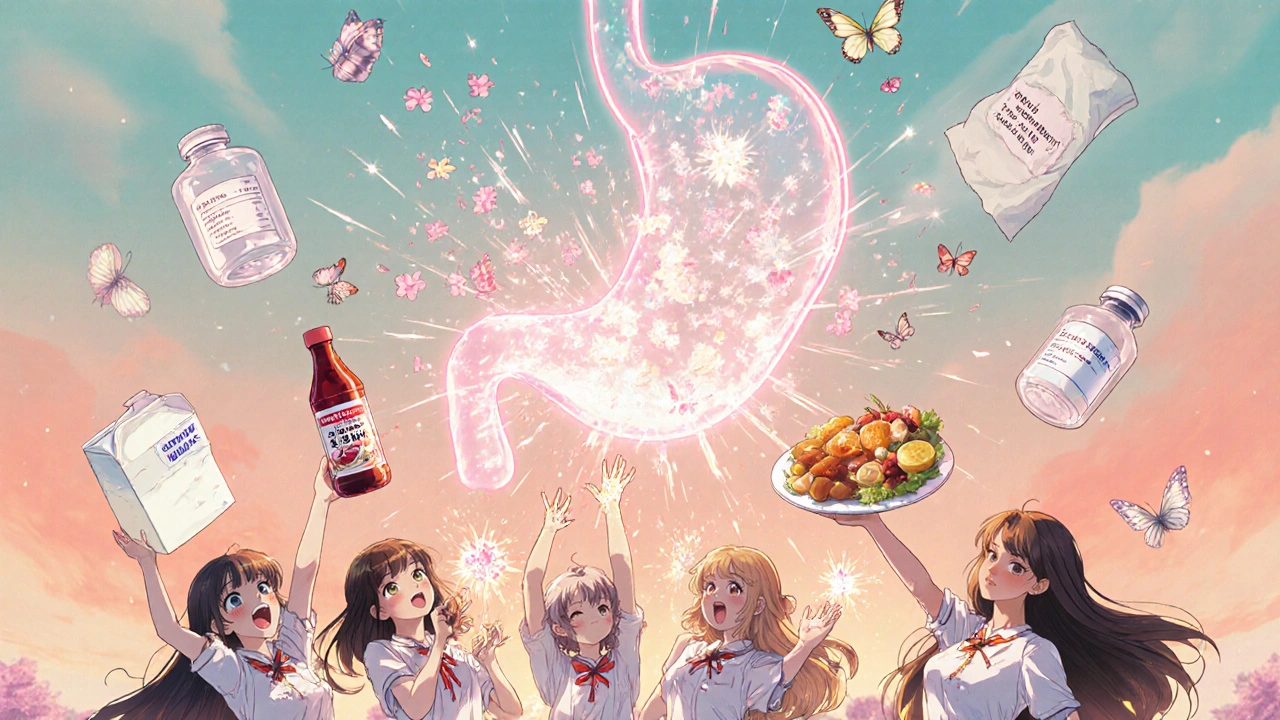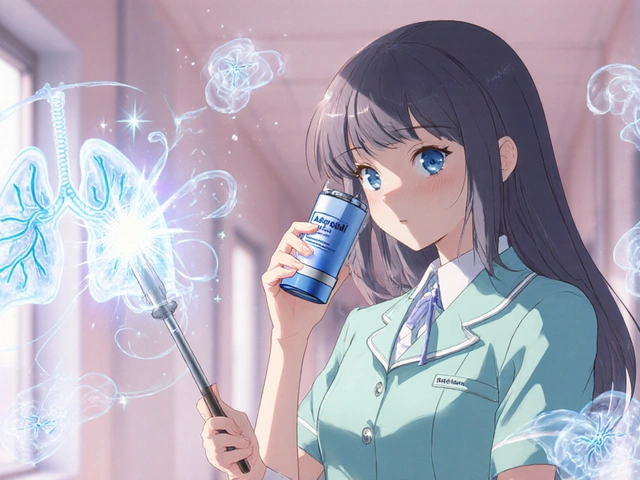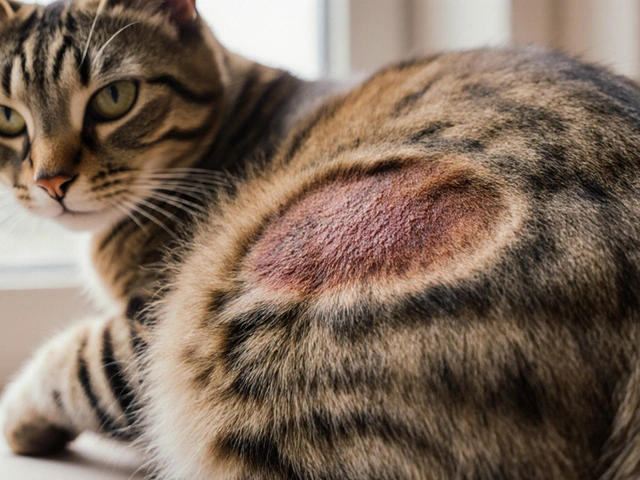Imagine swallowing a bite of bread and feeling like it’s stuck in your throat. Not just uncomfortable - painful. You cough, you drink water, you panic. This isn’t just indigestion. For people with eosinophilic esophagitis (EoE), this is everyday life. EoE is a chronic allergic condition where the immune system attacks food proteins, causing white blood cells called eosinophils to flood the esophagus. The result? Inflammation, scarring, and a narrowing that turns eating into a high-risk chore. It’s not rare - nearly 60 in every 100,000 people in North America have it. And the two main ways to fight it? Cutting out the foods that trigger it… or using a special steroid slurry that coats the esophagus like medicine armor.
What Exactly Is Eosinophilic Esophagitis?
EoE isn’t just acid reflux. It’s an allergic reaction trapped in your throat. When you eat something your body sees as a threat - usually milk, eggs, wheat, soy, nuts, or seafood - your immune system sends eosinophils to the esophagus. These cells don’t belong there. They release chemicals that inflame and damage the lining. Over time, the esophagus stiffens. Strictures form. Food gets stuck. In kids, it can mean failure to thrive. In adults, it means avoiding social meals, fearing choking, and sometimes needing procedures to stretch the esophagus.
The condition was first clearly defined in 1993, but it took years for doctors to realize it wasn’t just GERD. By 2007, it was officially recognized as its own disease. Today, we know it’s driven by a Th2 immune response - the same pathway behind eczema and hay fever. That’s why allergy testing often fails. Skin prick tests for milk or peanuts? They’re wrong about 70-80% of the time. The only way to know what’s triggering your EoE is to eliminate foods… and then slowly bring them back.
The Six-Ingredient Elimination Diet - And Why One Food Might Be Enough
For years, the go-to dietary plan was the six-food elimination diet (6FED): cut out milk, eggs, wheat, soy, fish/shellfish, and nuts. Studies showed it worked - about 65% of adults went into remission. But it’s brutal. No pizza. No peanut butter. No soy sauce. No yogurt. Social life collapses. Meal prep becomes a science project.
Then came the 2022 NIH trial published in The New England Journal of Medicine. The surprise? Removing just milk - one food - worked almost as well. Sixty-four percent of adults went into remission with a one-food elimination diet (1FED). That’s nearly the same as the six-food version. And for kids? The six-food diet still wins, hitting 75-80% remission. But for adults? Milk might be the big one.
Why milk? Research shows dairy proteins - especially casein - are the most common triggers across populations. In the U.S., 50-60% of EoE patients react to milk. In Spain, soy is bigger. But globally, milk leads. That’s why experts like Dr. Marc Rothenberg call it a paradigm shift. You don’t need to give up everything. Start with dairy. Give it six weeks. If symptoms improve, you’ve found your trigger. If not, then add back the others one by one.
There’s also the elemental diet - a liquid formula made of broken-down amino acids. It works in over 90% of cases. But it tastes like chalky sludge. Costs $1,500 a month. And no one wants to drink it for life. So it’s usually reserved for severe cases or kids who aren’t growing.

Steroid Slurries: How a Inhaler Becomes a Swallowable Treatment
If diet feels too hard, medicine offers another path: steroid slurries. These aren’t pills. They’re not swallowed like regular meds. They’re designed to coat your esophagus - like paint on a wall.
Doctors take a corticosteroid - usually fluticasone (Flovent) or budesonide (Pulmicort) - that’s meant for asthma inhalers. Then they mix it with water, honey, or applesauce. You don’t inhale it. You swish it in your mouth, hold it for 30 seconds, then swallow. The medication stays in your esophagus, reducing inflammation right where it’s needed.
It’s not perfect. About 15% of users get oral thrush - a yeast infection that makes your mouth feel like sandpaper. That’s why you rinse with water after swallowing (but don’t spit it out - you want the medicine to stay). Taste? Most people say it’s awful. Honey helps mask it. Budesonide slurry, according to a 2023 patient survey, works faster - 73% feel better in two weeks. Fluticasone? Slower, but easier to mix.
And now there’s Jorveza - the first FDA-approved medication specifically for EoE. It’s a budesonide suspension, dosed at 1.0 mg twice daily for 12 weeks. In trials, 64% of patients reached histological remission - meaning their esophagus looked normal under the microscope. Placebo? Only 2%. That’s huge. But Jorveza costs thousands. Insurance doesn’t always cover it. And it’s not a cure. You stop it, and the inflammation often comes back.
What Works Better: Diet or Drugs?
There’s no single winner. It’s about trade-offs.
- Diet: No side effects. No drugs. But it’s time-consuming. You need a dietitian. You risk nutrient gaps - especially calcium and vitamin D if you cut out dairy. And 40% of people relapse within six months when they start eating triggers again.
- Steroid slurries: Faster relief - often in 2-4 weeks. Easier than cutting out six foods. But thrush is common. Long-term use? Still being studied. And you’re still taking steroids, even if they’re topical.
Many patients combine both. Start with a steroid slurry to calm things down fast. Then switch to diet to maintain control. Or use diet first, and add steroids if symptoms don’t improve.
One patient from Reddit, ‘SwallowWithCare’, shared: “After ditching dairy for six weeks, I went from needing esophageal dilation every three months to being dilation-free for 14 months.” Another, ‘FoodFight2023’, said: “I tracked every bite for eight weeks. Only found out soy was my trigger. But I almost quit - it ruined my life.”

Real Challenges: Nutrition, Cost, and Long-Term Management
Managing EoE isn’t just about food and medicine. It’s about surviving daily life.
People on dairy-free diets often get low on calcium and vitamin D. That’s why doctors recommend supplements. Kids need careful monitoring to avoid growth delays. Adults struggle with social isolation. Birthday parties, dinners out, work lunches - all become minefields.
Cost is another hurdle. Jorveza costs $10,000+ a year. Elemental formulas run $1,200-$1,800 monthly. Even dietitian consultations - recommended by the American Partnership for Eosinophilic Disorders (APFED) - cost $150 per session. Some nonprofits, like the Cincinnati Center for Eosinophilic Disorders, now offer free hypoallergenic food pantries to qualifying patients.
And you can’t just stop treatment. EoE is chronic. You need endoscopies every 3-6 months to check if the inflammation is gone. No symptoms doesn’t mean no damage. The esophagus can scar silently.
What’s Next? Biologics, Biomarkers, and Better Tools
The future of EoE is changing fast. In May 2023, the FDA approved Dupixent (dupilumab) - a biologic drug originally for eczema and asthma - for EoE. It blocks the immune signals that drive eosinophil buildup. In trials, over half of adults reached remission. It’s given as a shot every two weeks. No dieting. No slurries. But it’s expensive. And not everyone qualifies.
Researchers are also working on biomarkers - blood or stool tests that can tell you which foods trigger your EoE without elimination diets. The NIH’s CEGIR study is testing this now. If it works, it could turn EoE management from a years-long guessing game into a simple blood test.
Component-resolved diagnostics are also emerging. Instead of cutting out “nuts,” you might only need to avoid a specific peanut protein. That’s huge. It means you can keep eating almonds, just not peanuts.
For now, though, the best advice is simple: Start with milk. Try a steroid slurry if you need quick relief. Work with a specialist. Don’t trust allergy skin tests. And remember - you’re not alone. Thousands of people are doing this. And slowly, the tools are getting better.
Can EoE be cured?
No, EoE is a chronic condition. But it can be controlled. With the right diet or medication, most people achieve remission - meaning inflammation drops to normal levels and symptoms disappear. The challenge is keeping it that way. Stopping treatment often leads to a return of symptoms. Long-term management is key.
Do allergy tests help find EoE triggers?
Not reliably. Skin prick and patch tests for food allergies miss the triggers in 70-80% of EoE cases. That’s because EoE isn’t an IgE-mediated allergy like peanut anaphylaxis. It’s a delayed, tissue-based reaction. The only proven way to find triggers is through elimination diets followed by controlled reintroduction - with endoscopy to confirm results.
Is budesonide slurry better than fluticasone?
Budesonide slurry tends to work faster - 73% of patients feel better within two weeks compared to 58% with fluticasone. It’s also more effective at achieving histological remission. But fluticasone is cheaper and easier to prepare. Many patients prefer it for that reason. The choice often comes down to cost, taste tolerance, and how quickly you need relief.
Can kids use steroid slurries?
Yes. Steroid slurries are commonly used in children with EoE. Doctors often mix budesonide with applesauce or honey to make it easier to swallow. The same precautions apply - rinse after swallowing to reduce thrush risk. For young kids, the six-food elimination diet is often tried first, but steroids are a powerful tool when diet alone isn’t enough.
What should I do if my symptoms come back after treatment?
Don’t ignore it. Recurrence means the inflammation is returning. See your gastroenterologist. You may need another endoscopy to check your eosinophil count. You might need to restart your diet, adjust your steroid dose, or try a new treatment like dupilumab. Many patients cycle between diet and medication. It’s normal. The goal is to find a sustainable balance that keeps your esophagus healthy.




Latrisha M.
Start with dairy. Seriously. I cut out milk for six weeks and my swallowing issues vanished. No slurries, no meds. Just plain almond milk and a lot of meal prep. It’s not glamorous but it works. I’ve been dilation-free for over a year now.
Jamie Watts
Bro why are we still talking about milk like its the holy grail? I tried that and nada. My trigger was soy and I only found out after 8 months of suffering. Skin tests are useless but so is guessing. You need an endo and a dietitian or you’re just wasting time
John Mwalwala
Did you know the FDA approved Jorveza right after the big pharma lobby pushed it through? They don’t want you fixing this with diet because pills = profits. The real cure is eliminating processed foods entirely but they’ll never tell you that. Also honey in slurries? That’s just sugar coating the problem literally and figuratively
Deepak Mishra
OMG I JUST REALIZED I’VE BEEN EATING SOY SAUCE FOR YEARS AND MY THROAT FEELS LIKE SANDPAPER???!?!?!?!?!! I’M CRYING RIGHT NOW AND ALSO DRINKING APPLE JUICE TO CALM DOWN 😭😭😭
ZAK SCHADER
This article reads like a NIH pamphlet. Who wrote this? A robot? No contractions. No personality. Just facts. And you expect us to care? In America we don’t need to be told what to eat. We need to be told why we should care. And frankly, I don’t.
Danish dan iwan Adventure
Th2-mediated eosinophilic infiltration is the core pathophysiological mechanism. Elimination diets target antigenic proteins. Steroid slurries inhibit cytokine release. But without biomarker validation, all interventions are empirical. You’re managing symptoms, not disease.
Ankit Right-hand for this but 2 qty HK 21
Why are we letting the West dictate EoE treatment? In India we’ve been using turmeric, ginger, and neem for centuries. This steroid slurry nonsense is just colonial medicine repackaged. And milk? That’s a Western obsession. In Asia, rice and lentils are the real culprits. Wake up.
Daniel Stewart
Is control not the same as surrender? We treat the inflammation, yet the self remains unchanged. The body rebels not because of food, but because the soul has forgotten how to listen. The slurry coats the esophagus, but does it coat the silence within?
Rachel Wusowicz
What if the real trigger isn’t food at all? What if it’s stress? Or glyphosate in our water? Or the 5G towers that have been quietly frying our immune systems since 2017? I’ve been on a raw vegan diet for two years and still get flare-ups. Coincidence? I think not.
Diane Tomaszewski
I used to think this was just me being dramatic. Turns out it’s real. And I’m not alone. That’s the thing no one says. You feel broken until you find others who get it. Just know you’re not crazy. Your throat isn’t broken. It’s just angry. And you can help it.
Dan Angles
As a gastroenterologist with over 18 years of clinical experience in eosinophilic disorders, I must emphasize that the six-food elimination diet remains the gold standard for pediatric populations. The 2022 NEJM data on milk-only elimination is compelling but requires validation in larger cohorts. Always confirm histological remission via endoscopy. Do not rely on symptom resolution alone.
David Rooksby
Okay hear me out - what if the reason steroid slurries work is because they’re basically a placebo with a side of steroids? I mean, think about it - you swish it around, you feel like you’re doing something, you get a little relief from the ritual. But the real reason people get better is because they stop eating out, stop drinking soda, stop stress-eating. It’s not the medicine, it’s the lifestyle change they force themselves into. And nobody wants to admit that.
Melanie Taylor
Just tried the budesonide slurry with honey. Tasted like a medicine cough drop that got into a fight with a swamp. But hey - I swallowed it. And two weeks later? I ate a slice of pizza without crying. 🙌